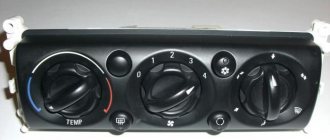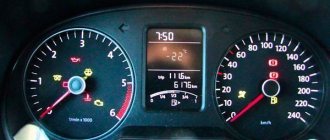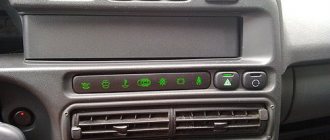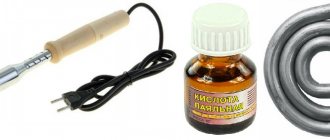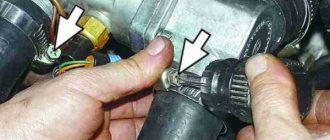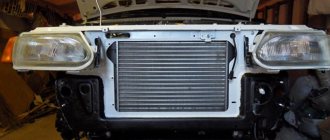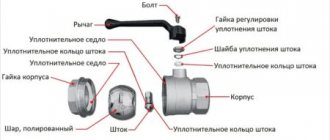A hot top and cold bottom of a car radiator is a normal condition only for cold engine after launch. If the engine has been running for several minutes, during which the coolant temperature has already reached 80–90 degrees (depending on the model), and the upper radiator pipe is hot and the lower one is cold, this is sign of trouble in the cooling system. However, there are exceptions to this rule.
The main reasons why the lower radiator hose is cold after warming up are a malfunction of the thermostat or pump , or a clogged radiator . This article will tell you how to determine the specific cause of the problem and what to do in this case.
What can cause the lower radiator hose to be cold and the upper hose to be hot?
Coolant circulation diagram: Click to enlarge.
Whether the lower radiator hose should be cold depends on the path of antifreeze.
After starting the engine, it first circulates in a small circle, bypassing the radiator, and after reaching a temperature of about 85 ° C , at which the thermostat partially opens, it goes to a large one.
In most models, coolant enters the radiator through the upper pipe, after which it is pumped down and returns through the lower pipe to the engine cooling jacket.
In those models where the thermostat blocks the flow of antifreeze from the radiator (for example, VAZ 2109), the lower pipe may be cold while the upper pipe is hot and before the engine warms up. If both channels or the radiator inlet are blocked (as on the Lada Granta), when the upper pipe warms up, both the radiator and the lower outlet should quickly warm up.
With a working cooling system, the bottom of the car radiator is cold and the top is hot only at the moment when the thermostat has already opened slightly, but the antifreeze has not yet reached the lower pipe. When the air temperature is low and the interior heater is on in winter, it takes longer for the coolant to warm up. In this case, the thermostat opens 10 minutes or more after the start of movement. At low air temperatures, it often happens that a car’s radiator is hot on top and warm on the bottom, since antifreeze quickly cools down as it passes through it.
Diesel engines warm up much slower than gasoline engines. Some cars with a diesel engine in winter can only fully use the large circle when driving at high speed (over 100 km/h) and during long periods of “taffy” in traffic jams.
You need to figure out why the lower radiator hose is not heating up and solve the problem in the following situations:
- the upper pipe is hot, and the lower one remains cold even after high-speed driving in warm weather;
- the radiator warms up only at the top, remaining cold at the bottom;
- coolant temperature readings on the dashboard go into the “red zone” ( more than 100–110 degrees );
- Antifreeze is boiling in the expansion tank.
The main reasons why the upper radiator pipe heats up and the lower one is cold:
Why does an air lock appear in the cooling system: video
- Thermostat is stuck in the closed or half-closed position.
- cooling pump is worn out and cannot create the required pressure.
- radiator channels with deposits.
- An air lock has formed in the cooling system.
Cooling system malfunctions are not always reflected in sensor readings. The coolant temperature sensor (coolant temperature sensor) may not be in contact with the overheated liquid and show a normal temperature. For the same reason, the radiator fan may not turn on in a timely manner.
Computer diagnostics only help identify problems with an electronically controlled thermostat. A problem with a mechanical valve is indirectly indicated by the non-corresponding readings of the DTOZ located on the block, in the cylinder head or in the area of the thermostat.
You cannot operate the car if the car is heating up and the lower radiator pipe is cold! This is fraught with a breakthrough of the gasket between the head and the block, failure and damage to the cooling system pipes, misalignment of the cylinder head, scuffing and wedge of the engine CPG due to overheating!
Checking the Thermostat
If you are still not sure that the thermostat is indeed stuck in one position, then follow the following procedure to definitively determine the cause of the engine overheating or taking a long time to warm up. That is:
1. Disconnect the negative terminal of the high voltage battery cable from the battery.
2. Drain some of the coolant from the system using the radiator cap or using the antifreeze drain hole provided in your vehicle. Drain approximately 4 to 5 quarts. That is, there is no such need to completely drain all the liquid from the cooling system. You need this in order to avoid the complete pouring of antifreeze from the system during the next effective step.
3. Remove the upper radiator hose.
4. Remove the thermostat housing.
5. Remove the thermostat.
6. Find the temperature marking on the thermostat housing at which it should begin to open. Remember this temperature.
7. Take a thermometer that can measure the temperature of boiling water.
8. Then take a saucepan and fill it with cold water. Place a thermometer in it and place it on the stove.
9. Next, place the thermostat in a pan of cold water and turn on the stove.
10. Now carefully monitor the temperature on the thermometer and the thermostat itself. If the thermostat is working properly, then when the water reaches the required temperature indicated on the thermostat body, it will begin to open. If this does not happen or the thermostat starts to come off when the water temperature reaches a higher temperature, then you will have to replace it with a new one, since this thermostat begins to open late at the wrong temperature or it is simply faulty.
If the thermostat opens when the water is heated to the temperature indicated on it, then it means it is fully operational.
How to determine the reason why the lower radiator hose is cold and the upper one is hot
The lower radiator hose is slightly cooler than the upper one, since the antifreeze coming from above cools down as it passes through the radiator. But, as a rule, we are talking about a relatively small temperature difference. When the outlet pipe/hose from the radiator does not warm up at all, this indicates a violation of the coolant circulation and heat exchange in the internal combustion engine.
All common reasons why a cold lower radiator pipe does not heat up normally are collected in the table.
| Possible reason | Consequence | How to understand/define it |
| The thermostat is stuck in the closed or half-closed position. | The coolant circulates in a small circle and does not cool. |
|
| The expansion tank cap valve is faulty. | The pressure in the circuit is not automatically regulated, which may cause air pockets. |
|
| The radiator channels (lines) are clogged. | Antifreeze does not pass through the radiator and circulates mainly in a small circle. |
|
| The water pump impeller is worn out. | The pump cannot create the required pressure, which causes the coolant circulation and heat transfer from the engine to the radiator to deteriorate. |
|
| There is an air lock in the cooling circuit. | Coolant circulation deteriorates, heat exchange is disrupted, and pipes may swell and rupture. |
|
What to do if the radiator or thermostat is faulty
So, the radiator does not perform its function properly for three reasons:
- it's packed outside;
- it is clogged from the inside;
- it is damaged and leaking.
If the radiator is clogged with dust or leaves, it can be cleaned. If it is clogged with scale from the inside, you can try to remove the radiator and clean it with a cleaning rod, blow it with air or rinse it with water under pressure. Doing this at home is problematic, as you will need a powerful compressor. Even in professional workshops with special equipment, it is not always possible to remove scale, so most often in such cases it is necessary to completely replace the radiator.
It is not practical to repair the thermostat. This will take too much time and effort, so it’s easier to just replace it. Sometimes it can be difficult to find and then get to without dismantling half the car. But if this succeeds, then removing the thermostat is easy. It is usually inserted into a groove. The old thermostat is removed and a new one is installed in its place. The main thing is not to forget to replace the thermostat gasket.
Cars that most often have heat transfer problems
On some cars, the situation where the upper radiator hose is hot and the lower hose is cold is more common than others. Such models and their “childhood diseases” are collected in the table below.
| Brand, model | Cause of the problem | How can I fix it? |
| VAZ 2106, 2101 and other “Classics” | Low quality of original components, in particular the thermostats themselves, which jam. | Instead of the original VAZ thermostat valve, use parts from other companies: Metal Incar, Finwhale, Vernet. |
| The cold bottom of the radiator in a VAZ “Classic” with high mileage is a consequence of corrosion of parts and clogging of the radiator channels. | Flush the radiator using a special fluid or, if that doesn’t help, replace it. | |
| VAZ 2108-21099, 2113-2115, Kalina | A faulty expansion tank cap valve does not allow maintaining operating pressure in the cooling system, which disrupts coolant circulation and causes the heater to heat poorly. | Replace the expansion tank cap. |
| VAZ 2110 – 2112, Lada Priora | On the VAZ 2110-2112, the lower pipe is cold, and the heater blows cold due to the predisposition to the formation of traffic jams and disruption of coolant circulation. | Monitor the condition of the cooling circuit, remove plugs, especially when replacing antifreeze. As a radical solution, you can replace the thermostat with a “six-hole” one (art. 21082-1306010) or from Lada Granta (21900-1306010), adapting the circuit to it. |
| The upper pipe is heated, and the lower pipe is cold, due to exhaustion and lack of pump performance. | Install an improved pump, like the Luzar Turbo. | |
| Skoda Octavia | On the Skoda Octavia, the lower radiator pipe is cold, and the engine begins to overheat due to a faulty oil heat exchanger gasket. | Replace the oil heat exchanger gasket. |
| Daewoo lanos, Sens, ZAZ Chance | Cold lower pipe and radiator, a consequence of early opening or jamming of the thermostat. | Replace the thermostat with a better one that opens at 87 degrees. |
| Ford Focus | On a Ford Focus, the bottom of the radiator is cold and the top is hot, usually due to a stuck thermostat. | Replace the faulty thermostat. |
| Mazda 3 | On a Mazda 3, the lower pipe is cold, usually due to a faulty thermostat. | |
| Volkswagen Passat | With high mileage, the pump and thermostat fail. | Replace the pump or thermostat. |
| Suzuki Grand Vitara | Airing of the cooling system due to pressure failure. | Remove air pockets. Replace the expansion tank cap, which often becomes clogged or, on the contrary, does not hold pressure. |
Consequences of engine overheating
The consequences of engine overheating can be different and depend on the temperature and the duration of its impact on the working parts of the unit:
- pistons melt and burn out;
- the cylinder head is deformed or cracked;
- the cylinder head gasket burns out;
- the partitions between the piston rings crack;
- oil leaks from under the seals;
- the main and connecting rod bearings are rotated.
- The crankshaft breaks.
Overheating that is not noticed in time can lead to complete jamming of the moving parts of the engine and the impossibility of its further restoration.
Why is half the battery cold?
When the radiator is not connected correctly.
The main reason why the battery is half cold may be that it is connected incorrectly. According to the rules for installing heating equipment in a heating circuit, the pipe supplying hot coolant must be connected to the top of the battery. The cold pipe or return, on the contrary, is to its lower part. Also read: “Radiator brackets.”
How can we explain this?
You need to take into account the laws of physics and remember that hot water is much lighter than cold water, and therefore is located in the upper part of the heating device. Gradually releasing its thermal energy to the surrounding air, the coolant cools down. Its density, and hence its weight, increases. He goes down. That is why often half of the battery is cold and half is hot.
In any case, if the radiator is half cold, you need to seek help from a specialist rather than try to solve the problem yourself. This can lead to equipment damage or injury.
Low coolant temperature.
The heating device was installed correctly, but still half of the battery is cold. What to do in this case? Very often, especially in frosty weather outside, the coolant enters the heating circuit at an insufficiently high temperature. Giving up heat to the heating element, it cools down completely. This is why the effect of a cold radiator from below is created.
Contamination inside the heating device.
Debris, rust, as a result of corrosion of the inside of the heating circuit, can lead to the fact that the batteries are half cold. What to do in such a situation? Before the start of the heating season, especially if the thermal distribution was organized several decades ago, it is necessary to clean the radiators. To do this, a locksmith from the relevant service is called and he performs all the work.
Things are worse if the radiators do not heat up after the start of the heating season. In this case, the riser of an apartment building or the heating circuit of a private building is completely taken out of service. After all, it is possible to remove contaminants from the radiator only when there is no coolant in it.
Air jams.
They may be the reason why half of the battery is cold. It is easy to check their presence if the supply pipe and return pipe of the heating element are equipped with ball valves or thermostats. They are simply blocked. Then the upper tap is opened while the lower one remains closed for only 10-15 seconds. If extraneous sounds and gurgling are heard when the coolant enters, there is air inside the heating element. It prevents the free circulation of hot water, so half of the battery does not heat.
The problem can be solved by simply bleeding the air. For this purpose, heating devices are equipped with a Mayevsky tap or an ordinary tap in the upper part. A container for collecting hot water is first installed under the locking mechanism. The Mayevsky tap opens and remains in this position until all the air leaves the heating device. The process is accompanied by spraying hot water under pressure. That is why it is recommended to cover the tap with a cloth.
The cross-section of the supply pipe is narrowed.
The heating element is installed correctly, it is new and there is no air inside, and the battery is half cold. Reason: a thermostat or tap with a narrowed flow area is installed. What does it mean? Through a pipe with a narrowed cross-section, half the coolant enters the radiator. As a result, the speed of water movement in the radiator decreases, and therefore the temperature of its surface decreases.
What needs to be done?
Dismantle the taps in front of the heating element. Before choosing a new device, be sure to consult a specialist. He must calculate the required cross-section of the valve, which will not affect the movement of coolant in the circuit.
Full room heating
The air temperature in the room will always be low if half of the radiator is cold, half is hot. The reason for this may be improper installation of the radiator, the presence of a tap in front of it with a narrowed cross-section, dirt and air inside the heating element. Any problem can be resolved if you seek help from a specialist. It is not recommended to carry out repairs yourself, as this can lead to equipment failure or injury.
>
VAZ 2106 is heating up: causes and consequences
Usually the VAZ 2106 heats up in the summer heat, but this can happen in the spring and autumn, and even in the frosty winter! In addition, in this situation there is a threat of failure of important components of the vehicle. A possible cause may be wear on the oil seals or rings on the piston. They, as a rule, lie down and stop performing their direct duties.
From high temperatures they become unusable, and increased combustion of oil begins. Also, when the engine overheats, the cylinder block becomes deformed. This is already a serious problem, since urgent repairs will require a considerable amount of money, which will certainly affect the family budget. It is not difficult to determine if a car engine is overheating. There is a sensor on the instrument panel for this purpose. The arrow will show a temperature of more than 100 degrees.
The sound of boiling liquid may be heard from under the hood of the car. Sometimes there is even steam. In this case, you urgently need to stop the vehicle and turn off the engine. Slowly open the hood, followed by a barrel of antifreeze so that the hot steam comes out. It is better to immediately turn on the fan to cool the overheated radiator.
Let's sum it up
As you can see, there are many reasons for engine overheating, and exceeding the operating temperature itself has a very detrimental effect on the condition of the internal combustion engine. In this case, it happens that the cooling system is clean, the antifreeze level is normal, the fan, pump and thermostat are working normally, but the engine still overheats. In this case, the culprit may be the OZ, since the fuel combustion process is disrupted when the ignition angle is knocked down.
In some cases, the cause of overheating is general wear and tear of the engine and its CPG. Simply put, the piston rings wear out, and insufficient sealing of the combustion chamber leads not only to disruptions in the combustion process of the fuel charge, but also to the breakthrough of hot gases. In this situation, the motor power drops and overheating may occur.
Also, prolonged and heavy load on the engine sometimes leads to overheating. For example, jammed brake pads can make it difficult to roll, causing the driver to actively load the engine. If you add to this the car air conditioner turned on in the heat, the engine will be loaded even more.
Correct driver actions
In situations where the engine overheats but the radiator remains cold, it is important to take the right measures to prevent the situation from getting worse and also try to prevent any serious malfunctions and costly breakdowns. Sometimes it happens that the driver panics ahead of time
This usually happens to motorists who have only recently gotten behind the wheel, or who have changed cars without having yet had time to get used to the peculiarities of its behavior and the operating modes of the engine itself.
Sometimes it happens that the driver panics ahead of time. This usually happens to motorists who have only recently gotten behind the wheel, or who have changed cars without having yet had time to get used to the peculiarities of its behavior and the operating modes of the engine itself.
Here we are talking about short-term overheating, which can to a certain extent be considered the norm for many engines. Short-term overheating usually occurs when sitting in a traffic jam for a long time. Then the temperature sensor arrow displayed on the dashboard rises to the critical red zone. But as soon as the car starts moving, when airflow appears due to oncoming air flows, and the cooling fan is activated, the temperature returns to normal. That is, first, try to observe and see whether the temperature will drop after a jump upward, to the red zone.
But you shouldn’t wait and watch when the car was in motion, that is, there was oncoming air blowing, or the fan was running. In such situations, experts give several useful recommendations:
- If the car was moving under completely normal conditions that do not provoke short-term overheating, but the temperature still begins to increase and reaches a critical level, do not immediately turn off the engine;
- Also, do not try to cool the power unit by pouring cold water on it from the outside, or by adding cold water to the expansion tank with cooling liquid;
- If you ignore these recommendations, fill the engine with water or add it to the tank, you will probably have to repair the engine. Moreover, such repairs are often accompanied by a mandatory replacement of the cylinder block and cylinder head;
- If you want to cool the engine, lower the engine temperature with a cold radiator to normal levels, it is better to drive off the road, stop and turn on the heater in the car. It doesn’t matter if it’s spring or summer, the cabin is warm enough without the heating working;
- Turning on the heater will remove excess heat from the engine, transferring it to the interior of your car;
- At the same time, you cannot turn off the engine itself. Just move the gearbox to neutral and leave the engine idling;
- Wait a few minutes after completing all the steps described;
- At the same time, check for any signs of coolant leakage. To do this, you will have to get out of the car, look under the car and into the engine compartment;
- If there are no leaks, then the manipulations carried out with the stove and the idle speed of the power unit did not allow the temperature to drop below the critical level, turn off the engine.
Next, you will need to call a tow truck or ask someone to tow you to get to the garage or the nearest service center. There you will find out the reasons, look for the culprit and carry out the appropriate repair and restoration work.
But there are situations when the engine needs to be turned off as soon as the engine temperature has reached its peak value. These are cases when, while driving, you suddenly saw steam billowing from under the engine compartment, and at the same time there were traces of a coolant leak. If you encounter such circumstances, stop and turn off the engine. There is no need to wait until the temperature starts to drop after turning on the stove. Otherwise, you risk completely ruining the engine.
The engine needs proper operation. This is the basis for its safety, effective, safe and long-term operation. Also, at the same time, always try to monitor the condition of the cooling system. Any traces of a coolant leak, a low level of coolant in the expansion tank, or an excessive increase in temperature under normal operating conditions should be a reason to check the condition of the entire system.
When faced with a situation where the power unit in your car is noticeably overheating, take appropriate measures, find the cause of the increase in temperature and eliminate it. If difficulties arise with self-diagnosis, it is better to immediately seek help from qualified specialists.
Heating system efficiency
- The main reasons for uneven heating
- How can this be dangerous?
- Ways to solve the problem
The main reasons for uneven heating
Batteries are an integral element of the room heating system, and the comfort of operation of residential and public buildings or various industrial buildings depends on its serviceability.
The most common reasons for uneven heating of heating radiators are: insufficient power of the circulation pump;
- failure to comply with slopes and angles during the installation of the pipeline system;
- incorrect thermostat mode; air lock;
- battery distortions.
Correct calculations of the power of the heating boiler, as well as commissioning of the heating system, are of no small importance. Please note that a slight temperature difference between the lower and upper parts is not a deviation. You should worry about a significant decrease in heating, it negatively affects the efficiency of the radiator
You should worry about a significant decrease in heating, it negatively affects the efficiency of the radiator
Please note that a slight temperature difference between the lower and upper parts is not a deviation. You should be concerned when the heating decreases significantly; it negatively affects the efficiency of the radiator.
How can this be dangerous?
The uniform heating of radiator batteries directly depends on the balance of the speed of the coolant and its temperature regime.
Incorrect operation of the heating system can cause:
- quite strong and unpleasant noise and vibration;
- disturbances in the acid-base balance of the thermal fluid;
- increasing the corrosive effect on heating elements;
- noticeable reduction in service life, as well as failure of batteries.
Ways to solve the problem
Not all heating system problems can be solved on their own. However, there are ways to bring radiators into working position.
To eliminate uneven heat output, you must perform the following steps:
- Bleed air from the heating system.
- Install an automatic air release valve.
- Install a circulation pump of sufficient power.
- Adjust the bypass.
It is important to annually flush the radiators and core, which very often become clogged during operation. If you cannot achieve uniform, stable heating of the radiator batteries on your own, then you should not delay in inviting qualified plumbing workers who can cope with problems of any level of complexity. published by econet.ru. If you cannot achieve uniform, stable heating of the radiator batteries on your own, then you should not delay in inviting qualified plumbing workers who can cope with problems of any level of complexity. published econet.ru
If you cannot achieve uniform, stable heating of the radiator batteries on your own, then you should not delay in inviting qualified plumbing workers who can cope with problems of any level of complexity. published econet.ru
If you have any questions on this topic, ask them to the experts and readers of our project here.
Clogged heater radiator
The stove, like the engine, has its own radiator located directly inside the heater in the cabin. If the car does not have a cabin filter, then all the street dirt flies directly into the heater, settling on the radiator. Accumulated dust and leaves that interfere with normal operation will have to be removed manually by partially disassembling the stove body.
The stove radiator can become clogged not only outside, but also inside. This happens due to the use of low-quality coolant, mixing antifreeze with antifreeze, and also due to the use of cooling system sealants not according to the instructions. It is difficult to clean the inside of the radiator: special flushing can help, but often the radiator has to be removed and replaced with a new one.


